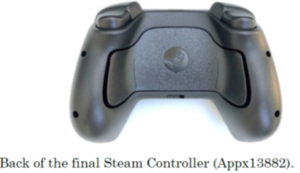On Measuring Up Video Game Controllers: A Lesson in Claim Language Indefiniteness
By Natalie Grace | April 27, 2023
In a precedential opinion decided April 3, 2023, Ironburg Inventions prevailed on appeal against Valve Corporation in a dispute regarding indefiniteness of the claim language of U.S. Patent 8,641,525 (the “’525 patent”) describing a hand-held controller for a video gaming console. Ironburg Inventions Ltd. v. Valve Corporation, Docket No. 2021-2296, -2297, 2022-1070. Regarding the back controls of the claimed controller, Valve contended that the meanings of both the phrase “elongate member” and the phrase “extends substantially the full distance between the top edge and the bottom edge” could not be understood with reasonable certainty by one of skill in the art when read in light of the specification and prosecution history. The Federal Circuit Court affirmed the district court judgement that each phase is not indefinite (a.k.a. can be understood with reasonable clarity by a POSITA).
Claim 1 reads as follows:
A hand held controller for a game console comprising:
an outer case comprising a front, a back, a top edge, and a bottom edge, wherein the back of the controller is opposite the front of the controller and the top edge is opposite the bottom edge; and
a front control located on the front of the controller;
wherein the controller is shaped to be held in the hand of a user such that the user’s thumb is positioned to operate the front control; and
a first back control and a second back control, each back control being located on the back of the controller and each back control including an elongate member that extends substantially the full distance between the top edge and the bottom edge and is inherently resilient and flexible.
The following images illustrate a back view of Valve’s accused device presented next to figure 2 of the ‘525 patent.


First, the district court along with both parties agreed that to be elongate, a shape must be longer than it is wide. However, Valve argued that “elongate member” is indefinite based on the patent failing to provide guidance on just how much longer than wider a shape must be to be deemed “elongate.” The argument regarding the meaning of “elongate member” is not a new one, as illustrated by this decision. The Federal Circuit cited to three prior cases ranging from 1983 to 2015 involving the claim term “elongate member” as well as a fourth case from 2018 involving the phrase “elongated and substantially straight” in relation to a baffle. See Exmark Mfg. Co. v. Briggs & Stratton Power Prods. Grp., 879 F.3d 1332, 1346 (Fed. Cir. 2018) (baffle); Biosig Instruments, Inc. v. Nautilus, Inc., 783 F.3d 1374, 1378 (Fed. Cir. 2015); Hologic, Inc. v. SenoRx, Inc., 639 F.3d 1329 (Fed. Cir. 2011); Thomas & Betts Corp. v. Litton Sys. Inc., 720 F.2d 1572 (Fed. Cir. 1983). Here, the district court and Federal Circuit both agreed that elongate member, as used in the subject patent, could be understood by its “plain and ordinary meaning” as in the cited cases.
Second, Valve argued that the phrase “extends substantially the full distance between the top edge and the bottom edge” is indefinite because, basically, there is no definite “bottom edge” to point to in either the patented controller or the accused controller. As can be seen in the images reproduced above, these devices are far more complex in contouring than, say, the vintage Atari joystick. Regardless, the Federal Circuit chalked this argument up to a disagreement regarding whether the accused controller is an infringing device rather than whether the claims are indefinite.
In a dissenting opinion, Circuit Judge Clevenger argued that, when patents include claims requiring measurements, the patent needs to provide “reasonable certainty in sufficiently teaching how to make the measurement.” Dissent, citing Dow Chemical Co. v. Nova Chemicals Corp., 803 F.3d 620 (Fed. Cir. 2015); Teva Pharmaceuticals USA, Inc. v. Sandoz, Inc., 789 F.3d 1335 (Fed. Cir. 2015). In the present case, each side’s expert chose a very different method for performing the measurement. Valve’s expert, for example, started with the center length of the elongate member as an axis and measured the distance between the point where this axis touched the top edge of the controller and the point where it touched the bottom edge of the controller. To perform this measurement accurately, Valve’s expert disassembled the controller in an attempt to minimize the effect of the curvature of the back of the controller on the measurement between the two points. This method resulted in the length of the elongate member extending only 53% of the distance between the top edge and the bottom edge. Ironburg’s expert, conversely, used an image of the controller to measure the distance between the top edge and the bottom edge in manner that did not consider the positioning or the orientation of the elongate members. Ironburg’s expert determined that the elongate member was actually longer than the distance between the top edge and the bottom edge.
“The test for indefiniteness … depend[s] … on whether the claim delineates to a skilled artisan the bounds of the invention.” SmithKline Beecham Corp. v. Apotex Corp., 403 F.3d 1331, 1340-41 (Fed. Cir. 2005). Reasonable minds may differ; however, when the difference is between 53% and 100+%, despite the outcome of the present case, it is apparent that the claims could have been drafted with a greater level of clarity to close the window (or perhaps, in this case, the wide open barn door) on such arguments. This is a good reminder to all practitioners drafting claims involving measurements or relative placements of product features. Plus, next time you consider using the term “elongate,” remember just how contentious this term appears to be based on the case law cited above and ensure that the detailed description includes some objective guidance to support its interpretation.